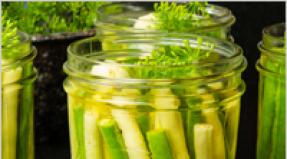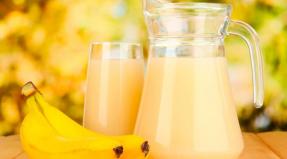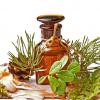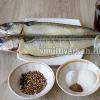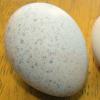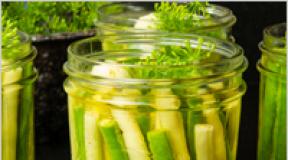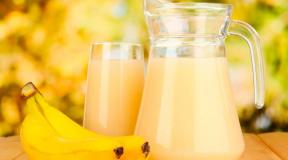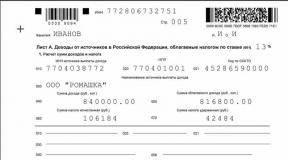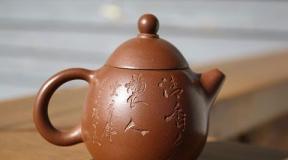Banana puree. Banana puree (step-by-step recipe with photos)
Age: from 6 months
Today, pediatricians are of the opinion that it is worth starting any complementary feeding at 6 months, and complementary feeding with fruit purees only after introducing vegetables and cereals into the infant’s diet. Ideal as the first fruit complementary food -. Then you can try plum, banana and other fruits.
Simple banana puree for complementary feeding
Serving option:
Ingredients for cooking:
- 1 banana
Mash a more ripe banana with a fork. You can add a little boiled water to make it thinner. Places where the skin has darkened must be cut off!
How to make banana puree for babies
1. Banana puree with apricots and porridge
Ingredients:
- 2 apricots
- 4 tbsp. spoons of water
- 10 g rice cereal or any other ready-made porridge
- half a banana
Step by step recipe "Banana puree for babies" :
- Pour hot water into the vessel.
- Slice whole apricots vertically and horizontally.
- Place in water for a couple of minutes, then the skin will be very easy to remove.
- Apricots should be skinned and pitted, then cut into small pieces and chopped.
- Simmer the apricots for about 10 minutes with the lid closed in a small amount of water. Make sure that the puree does not burn.
- Mix apricots and bananas and prepare puree in a blender (you can also simply mash with a fork).
- Mix fruit puree with rice cereal or any other ready-made porridge.
2. Apple-banana puree for feeding children
Ingredients:
- half an apple
- half a banana
Step by step recipe "Apple-banana puree" :
- Peel the apple well and cut into small pieces.
- Place in a saucepan with a small amount of water (50 ml) and bring to a boil.
- Cook for about 7 minutes over low heat.
- Peel the banana and cut off the ends.
- Prepare puree from apples and bananas, let cool slightly.
3. Apple and banana puree with juice
Ingredients:
- 1 apple
- 1 banana
- 2 tbsp. spoons of orange juice (or any other)
Step by step recipe "Banana puree with juice" :
- Peel the apple, grate it on a fine grater - for children from 9 months. For infants, it is better to pre-cook the apple into pieces, as in the previous recipe.
- Mash the banana with a fork and combine with the apple, stir.
- Finally, add the juice.
Banana puree conditionally suitable for feeding infants and first complementary feeding for children up to one year old (from 6 months). Considering the fact that banana is an exotic fruit, it should be introduced after apple and pear.
All children adore the tasty and satisfying yellow exotic crescent. The sweet banana pulp, without seeds or segments, is whole, aromatic, gives indescribable pleasure and brings many benefits to the little person’s body. Absolutely hypoallergenic, it is perfect for baby food. Naturally, parents are interested in the age at which bananas should be introduced into infant feeding.
All children love bananas, but little ones need to introduce them into complementary foods gradually.What beneficial substances are contained in bananas?
In addition to being hypoallergenic, banana boasts its rich composition. Tropical fruit contains:
- The most important vitamins and microelements that support the proper development of all systems of the baby. Thanks to the presence of fluorine, potassium, magnesium, sodium, heart function improves, vitamins enrich the composition of the blood, minerals form bone and muscle tissue.
- The fruit consists of 20% starch, which serves as a supplier of glucose. Once in the body, it is easily broken down, ensuring good absorption of the product and supplying the glucose necessary for the overall development of the baby.
- B vitamins are needed by the baby’s nervous system; they are involved in the formation of skin and hair cells and are responsible for the baby’s restful sleep.
- Fiber is a source of energy and an element that has a positive effect on the child’s digestive system.
- The combination of all the beneficial substances of the fruit affects concentration. The fruit has the ability to lift spirits, reducing the whims of infants and setting up school-age children for academic success.
If we talk about the medicinal properties of the tropical fruit, its help in treating the early stages of bronchitis and cough is well known. The pulp of the fruit is crushed in a blender, mixed with milk or water, boiled and given to the baby warm as a medicinal drink. To give the dish a healing effect, many mothers add lemon juice and bee honey to the resulting mixture.

 A banana with hot milk and honey will quickly relieve your child of an irritating cough.
A banana with hot milk and honey will quickly relieve your child of an irritating cough. Who shouldn't eat fruit?
Dear reader!
This article talks about typical ways to solve your issues, but each case is unique! If you want to know how to solve your particular problem, ask your question. It's fast and free!
When planning to give a banana, mothers should know how much of it their child can eat. Limiting the quantity is recommended when:
- colic, constipation, diarrhea and other digestive problems;
- high blood sugar (diabetes prevention);
- spasms and problems with muscle relaxation, so as not to provoke muscle hypertonicity;
- It is not recommended to eat the fruit before the main feeding; it can kill your appetite.
Some diseases exclude the sweet exotic fruit from the baby’s menu completely. The fruit should not be consumed:
- for serious problems with the cardiovascular system (congenital defects, disturbances in the functioning of the heart valves);
- if elevated calcium levels and brittle bone syndrome are detected;
- malfunction of the thyroid gland;
- for neurological diseases (epilepsy, spontaneous seizures and fainting);
- when prohibited by a pediatrician or other children's specialists based on medical indications.
If you have colic or any digestive problems, banana should be temporarily excluded from your diet.
Can a banana cause allergies?
Cases of allergy to the sunny fruit are so rare that it can be safely given to children from 5-6 months. The banana has been on our store shelves for a very long time, so it is natural that the body has adapted to it. At the genetic level, the mother transmits information to the baby about the product as safe and familiar. However, when using a banana for complementary feeding, you can sometimes encounter a negative reaction from the child’s body.
The reason here is not in the fruit itself, but in the way it is stored. Fruits are delivered to us from distant countries, they travel a long way. Naturally, the seller tries to preserve the presentation, uses chemical compounds, and so they become the culprits of the allergy. Penetrating under the skin of the fruit, chemical compounds infect its pulp, which leads to allergies in the baby.
When to introduce it into a baby's diet?
Pediatricians have different opinions on the age at which a child can be given a banana. Some doctors believe that fruit should not be given to a baby before 8 months. Others see nothing wrong with introducing complementary foods to a 6-month-old baby. Experts are unanimous that it is not advisable to start complementary feeding with a banana. It is better to let your baby try vegetables, otherwise, after the sweetness of a tropical fruit, he will turn away from tasteless foods. The table by age and quantity will help you navigate:
Sliced or whole bananas can be given to your baby as early as one year of age.
By the way, the fruit takes a long time to digest, so you should not give your baby this tropical fruit in the evening feeding. The baby's developing digestive system does not accept such food well, which leads to sleep disturbances and tummy discomfort.
Maturity and storage conditions
The long road from banana plantations to the store counter is the main reason why fruits of varying degrees of ripeness appear before us. Which banana is best for a child?
- Green fruit. Such fruits are filled with harmful tannin. Entering the intestines, tannin is fermented and provokes the fermentation process, increasing gas formation.
- Overripe fruit. The fruit is easily identified by its black spots and darkened skin. Eating it causes constipation in infants. In addition, it contains a lot of glucose, which can cause allergies.
- Ripe fruit. The optimal choice for an infant. The fruit is evenly colored in a bright yellow-lemon color, the peel is smooth, without spots or cracks. If you see that the fruit is a little unripe, keep it at room temperature for two days and it will reach ripeness.
Tropical sweetness does not last long, but there are a few little secrets that help keep it in good shape for several days. Storage conditions:
- keep the fruits in a cool place away from light;
- In the refrigerator, fruit quickly deteriorates and becomes saturated with other odors, so it is not recommended to store it this way;
- store for no more than 5 days;
- provide air access, do not store the fruit in a plastic bag;
- A banana ripens faster if it sits with an apple.
If stored properly, bananas will retain their freshness for a long time.
How can you cook a banana?
Obviously, bananas should be given to a baby at 5 months in the form of puree. They are prepared with the addition of breast milk or formula so that the taste of the dish is familiar to the baby. In addition, by diluting the thick pulp with milk, you will get a puree consistency that is better absorbed by the baby’s digestive system. How to properly prepare fruit for consumption?
Taking a banana for the first feeding, peel the fruit and remove excess veins. Then heat treat the fruit: boil it in a water bath or in a double boiler. Cut the fruit into small slices, place in a steamer or bowl, cook for 6-7 minutes. Remove the well-heated pulp and mash it into a puree, add a small amount of milk or mixture. We offer you several ways to serve fruit:
- Place the fruit in and serve it to the baby in this form. A safe way that allows you to simultaneously massage your baby’s gums.
- If you want to quickly prepare puree, scrape the pulp from the whole fruit with a spoon.
- You can make puree from fruit in several ways: grind the pulp with a fork, pass through a blender, grate. A liquid consistency will be obtained if you add mixture or breast milk to the banana puree.
- Buy the finished product in the store. Small jars can be taken for walks and are convenient to store. Store-bought puree can be prepared by combining banana with other fruits.
- Kids love the taste of banana and apple. Make a puree with these ingredients.
- For children older than 3-4 months, banana can be added to kefir or yogurt. The taste of the fermented milk product will improve.
- Bake the fruit in the oven, collect the released juice, pass the pulp and juice in a blender. The puree will be tender and tasty.
Babies will definitely like banana-apple puree with its unusual taste (we recommend reading:)
What dishes can you prepare?
Banana dishes begin to be prepared for seven-month-old babies, when they are ready to switch from dairy foods to a variety of foods. Pediatricians recommend preparing porridges and casseroles with bananas closer to 9-10 months or a year. Our recipes will help you complement the menu of your treasure with a pleasant banana taste. When choosing dishes, be guided by the taste of your child.
The dessert is prepared for children closer to the age of one year. No sugar is added to the dish; the sweetness of the fruit itself is enough. You will need:
- cottage cheese – 50 grams;
- half a medium banana.
Preparation:
- Cut the fruit into small pieces and blend in a blender.
- Add cottage cheese to the whipped banana. Add a tablespoon of drinking water.
- Beat the mixture in the blender again until the mixture becomes homogeneous. Dessert is ready.
For children, it is better to grind the banana curd dessert using a blender
Rice milk porridge with banana
We offer you a recipe for delicious milk and fruit porridge for children from 1 year old. The dish is hearty and energizes the child well. We need to take:
- Short grain rice – 150 grams;
- milk – 150 ml;
- drinking water – 150 ml;
- large banana;
- sugar – 2 tbsp. spoons;
- salt - to taste;
- butter – 30 grams.
Preparation:
- Wash the rice well, fill it with water, and bring to a boil. Cook over low heat for 20 minutes, cover the pan with a lid. Salt.
- The milk needs to be boiled.
- Pour milk into the porridge, add sugar, boil for another 7 minutes, turn off.
- Mash the banana with a fork and add it to the finished porridge, stir.
- Add butter when serving the dish.
What puree should I buy in the store?
Many mothers prefer to buy ready-made baby food in the store. Let's give credit to the manufacturers, they try to strictly adhere to the recipe and produce a truly useful and high-quality product. The consistency of ready-made purees is ideal. There is a variety of packaging - from traditional glass jars to single-use bags. The jars can be taken for future use, the bags are suitable for walking. How to choose the right puree in the store:
- Choose products from well-known and well-established brands: Hame, Pelenok, Gerber, Fruto Nyanya.
- When starting complementary feeding with banana, take puree only from this fruit. Apple or peach puree can be given to the child after he gets used to the first taste.
- Take jars packed on top with film or adhesive tape. This choice will protect you from buying a fake.
- Check the ingredients of the puree to make sure there is no sugar in it. The best product is offered by the company Spelenok.
- Give preference to a product in small packaging. A jar weighing 80 grams is the best option. The baby will eat all the purees, and you don’t have to collect the leftovers.
Once you have decided the age when you are ready to offer your baby a new fruit, don’t hesitate. Treat your baby to a sweet exotic fruit. Now you know that it is safe, easily digestible, and most children like it. In addition, we told you how to cook banana. You may come up with your own recipes, knowing what your child likes, but in any case, a banana will bring benefit and pleasure to the baby.
Banana puree is a product obtained through mechanical processing of fruits. Outwardly, it looks like a homogeneous mass of pale yellow color (see photo), which has a taste and aroma characteristic of bananas.
This product is simply ideal for baby food, but should be given from the age of 5 months.
Beneficial features
The benefits of banana puree lie in its chemical composition, since almost all the beneficial substances that are in the fruit itself pass into it. This puree supplies the body with energy, so it is recommended for use by people who are subject to regular physical and psychological stress. Banana puree is an easily digestible food, but also high in calories.
It contains vitamin A, which is necessary for vision and collagen production. The puree also contains B vitamins, which have a positive effect on the functioning of the nervous system, which helps cope with insomnia and fatigue.
Banana puree is an anti-allergenic product, which is important for children and people prone to food allergies.
When you consume the product, your body begins to produce a happiness hormone, which helps improve your mood. The puree also has the ability to lower blood cholesterol levels. Bananas strengthen the immune system, which increases the body's protective functions against the negative effects of viruses. When consumed regularly, puree improves the functioning of the digestive system. In addition, banana puree improves the functioning of the heart, liver and brain.
Banana puree is an effective aid in treating severe cough. In folk medicine, there are several proven recipes using banana puree, which help cure a cold in a few days. Let's look at some of them.
|
Composition of the product |
How to cook? |
How to use? |
|
Banana puree with cocoa and homemade milk |
In banana puree (from one banana), you need to add six teaspoons of cocoa powder and pour in about two hundred milliliters of hot boiled homemade milk, stirring well. |
Take a banana milkshake in the evening before bed, preferably warm, for about five days. |
|
Banana with honey (first recipe) |
You need to mash one banana, pour about two hundred milliliters of boiling water into it and add one a teaspoon of natural honey. Stir the cocktail well and let it brew for about thirty minutes. |
Take fifty milliliters every three hours. |
|
Banana with honey (second recipe) |
First, you should mash a ripe banana, pour in one teaspoon of natural honey, a teaspoon of mint tincture and freshly squeezed lemon juice. Beat the mixture with a blender until smooth. |
To get rid of a sore throat and sore throat, you need to take a medicinal cocktail three times a day, two teaspoons for five days. |
|
Banana with milk |
You need to mash a ripe banana fruit, pour about one hundred milliliters of boiling homemade milk into it, and also add one teaspoon each of powdered sugar and butter. The resulting mass should be whipped using a blender until smooth. |
Drink a banana milkshake once a day every day until the cough stops. |
|
Banana with plantain alcohol tincture |
Pour plantain tincture into the whipped banana puree and stir thoroughly. |
Drink three teaspoons one hour after meals. Not allowed to be given to children as it contains alcohol. |
|
Ripe banana and boiled water |
Peel two ripe bananas, cut off the ends, mash the fruits into a puree and pour two hundred milliliters of very hot water. Place the fruit mixture on the stove and boil, stirring continuously. As soon as the fruit mixture begins to bubble, the container can be removed from the heat. |
Drink daily for about five days. The banana broth should be warm. It cannot be stored for a long time, so you need to prepare a new drink every day. |
|
Ripe banana with water and granulated sugar |
Pour about two hundred milliliters of boiling water into the crushed banana and add two teaspoons of granulated sugar, stir the mixture well and let stand for about thirty minutes. |
Take one hundred milliliters every two hours for five days. |
However, in addition to using traditional recipes, you need to contact your pediatrician to prescribe an additional list of necessary medications.
It should also be remembered that eating bananas is not recommended for those children who have obesity, diabetes, allergies to the product, constipation, or high acidity of gastric juice. In addition, experts advise eating bananas only after meals, and not on an empty stomach.
Use in cooking
The use of banana puree in cooking is very diverse; it is not only an excellent independent dish, but also an addition, for example, to porridge. It can be used as a filling for baked goods and also for desserts. You can make milkshakes and other drinks using banana puree.

For variety, you can complement the taste of the puree with various fruits and berries. Bananas go well with many of them.
How to make banana puree at home?
 Since manufacturers increasingly use various preservatives and other food additives to prepare banana puree, it is better to prepare it yourself at home.
Since manufacturers increasingly use various preservatives and other food additives to prepare banana puree, it is better to prepare it yourself at home.
To ensure that the puree is of the highest quality and healthiest, choose ripe fruits without dark spots. To obtain banana pulp, you can use any of the usual utensils: a grater, a fork, a blender or a sieve. The fruit just needs to be peeled and ground into a homogeneous mass. That's all, homemade puree is ready. You don't even need to add sugar.
If you want to vary the taste, you can add a small amount of orange or lemon juice.
How to make it for a baby?
To make banana puree for your baby, you need to take one ripe banana. (it should be yellow in color, without any dark spots), wash it well, peel it, cut off the ends, take a little ripe pulp and mash thoroughly with a fork or chop using a blender. Then you need to pour a little warm breast milk or formula milk into the banana puree and mix well.
It is best to give your baby fruit puree to try after the main meal so that his appetite does not deteriorate. You should also remember that you need to start introducing new complementary foods only after six months, starting with a small teaspoon, to monitor the baby’s reaction. If within two days the baby’s condition has not worsened, allergies or constipation have not appeared, then you can continue to give banana puree. If there is any negative reaction from the child’s body to a new product, you should refrain from fruit puree.
Banana puree can also be varied with other fruits, which will also be beneficial for the baby.
|
Banana puree |
Cooking method |
|
With apricots and porridge |
Pour four tablespoons of boiled hot water into a shallow container and throw in two washed apricots. After two minutes, the fruit can be peeled and the seeds removed from the pulp. Peeled apricots need to be cut and crushed, and then add a little water and boil for about ten minutes, stirring constantly. Then the apricot puree should be mixed with half a ripe banana and chopped using a blender. The finished fruit puree should be added to ten grams of ready-made baby porridge and stirred well. |
|
With apples |
To make fruit puree, you will need half a sweet apple, which should be washed and removed from the skin and seeds. Then put it in a small container, add fifty milliliters of water and boil for about seven minutes. Next, add half a banana to the apple and puree using a blender. |
|
With apple and juice |
Suitable only for children over nine months of age. You need one sweet apple, which should be washed, peeled, seeds removed and grated. Then add applesauce to one banana and grind with a blender, and then pour in two tablespoons of any fruit juice and stir well. |

Recipe for preparing for the winter
The recipe for making banana puree for the winter is quite simple. To do this, you must first squeeze the juice from two ripe lemons. Then you should take one kilogram of ripe bananas, wash them well, remove the skins, finely chop them and put them in a blender. We do the same as with bananas with two sweet apples. Add lemon juice to the chopped fruits and grind with a blender. Pour the banana-apple puree into an enamel-coated pan, add about six hundred grams of granulated sugar and about four hundred milliliters of water. Boil for thirty minutes over low heat, stirring continuously. Distribute the finished fruit puree into sterilized containers and preserve.
You can also freeze banana puree. To freeze, you need to wash ripe bananas (the quantity is at your discretion), peel them, and chop the fruits with a blender. Pour lemon juice into the banana puree (one tablespoon of juice is needed for two hundred and fifty milliliters of puree), mix well, and then pour the puree into a plastic container with an airtight lid. Store in the freezer for no more than four months.

Harm of banana puree and contraindications
Banana puree can be harmful to people who have an individual intolerance to the product. This product has few contraindications:
- excess body weight,
- diabetes,
- digestive disorders,
- allergy.
After 6 months, a period of acquaintance with “adult” food begins for the baby, and every mother strives to pamper the baby with new tasty and healthy products from the adult table. Despite this, it is important to introduce cereals, vegetables, and protein products according to a scheme agreed upon with the pediatrician. After six months of age, it is possible to use fruits in children's diets. As a rule, bananas become the favorite tropical fruit of many kids. This fruit has a distinct sweet taste and pleasant aroma. In order for the tender pulp to benefit the baby, the mother needs to figure out at what age to start dating, how to choose the fruit and prepare healthy banana puree.
Eating a banana is beneficial for both children and adults. The fruit is characterized by a unique composition, rich in vitamins, minerals and trace elements. It contains a lot of potassium, phosphorus, magnesium, iron, vitamins A, C, E, B6 and fiber. The combination of these components determines the positive effect of the fruit on the child’s body.
Systematic consumption of the fetus affects the processes in the baby’s body as follows:
- improves the functioning of the cardiovascular system;
- increases fermentation;
- raises the level of hemoglobin in the blood;
- strengthens bone tissue;
- increases the body's immune strength;
- improves the condition of the skin and mucous membranes;
- normalizes the functioning of the gastrointestinal tract.
Banana is a high-calorie food. 100 g of pulp contains 100 kcal. If the fruit is green, the figure is 108 kcal, and in dried fruits it is 298 kcal.
These tropical fruits are part of the group of hypoallergenic products. Allergies to fruit are rare. Most often, negative manifestations are associated not so much with the composition of the fruit, but with the use of chemical components to extend shelf life and improve appearance. If an infant tries pulp for the first time, it is important to carefully monitor the baby’s well-being throughout the day. It is worth refusing to consume overseas fruit in case of violations. Negative reactions in this case may include diarrhea and an allergic rash. This situation requires a mandatory visit to the pediatrician and appropriate treatment. It is worth remembering that if you are allergic to banana, cross-allergic reactions to gluten and plantain pollen are possible.

Despite the significant benefits of this tropical fruit, there are cases when it can harm children. You should not treat this high-calorie fruit to an obese child, diabetes mellitus, or toddlers with gastrointestinal disorders. High glucose levels can cause bloating.
Rules for introducing complementary foods
It is necessary to choose a fruit for cooking based on its external characteristics. The most important factor is color. You should not buy green fruits, because they contain the harmful substance tannin, which causes fermentation and gas formation in the large intestine. Overripe bananas are also not healthy because they contain excess glucose. Preference is given to bright yellow fruits without spots or damage. It is better to buy a slightly unripe fruit and leave it for several days to ripen.
Bananas should be stored in a dark and dry place at a temperature of 10–15 degrees. Do not leave them in a bag or put them in the refrigerator.
If the child is healthy and has already received complementary foods, you can give him a raw banana, scraping out the pulp with a spoon. Experts recommend thermally treating the fruit the first 2–3 times and blending it using a blender. You can steam the fruit for a few minutes or cook it in the usual way; young mothers often use a slow cooker. Exposure to high temperatures is necessary to eliminate harmful substances and make food more prepared for the child's imperfect gastrointestinal tract.
Dr. Komarovsky believes that for children who do not experience digestive problems, banana complementary foods can be prepared without heat treatment.
Banana goes well with pumpkin, apple, sour berries and fruits. Banana puree can be added to fermented milk products: cottage cheese and yoghurt. The exotic fruit goes well with oatmeal, semolina and rice porridge. After 7 months, you can introduce the baby to multi-component puree based on the yellow fruit.
It is not advisable to store the finished mixture: the puree becomes gray and loses its beneficial properties. The maximum time in the refrigerator is 1 day; an open jar of industrial banana puree can be stored for no more than a day. Bananas can be harvested for the winter, made into puree, jam, preserves, dried and even dried. However, there is no need for such preparations, because the fruit is on sale all year round, which allows you to prepare banana puree and other dishes for babies from fresh fruits.
At what age is banana introduced into a baby’s diet?
Pediatricians and children's nutritionists note that fruit purees are offered to the baby after introducing him to vegetables and grains. Having tasted the sweet pulp, the baby may not want to eat the blander zucchini, pumpkin or. The first attempts at introduction are made after familiarization with applesauce and not earlier than six months. The best age to start eating tropical fruit is 8–9 months.
You can give a banana to a baby, following the principles of introducing a new product. If the little one begins to get sick, is preparing for vaccination, or is planning to move to a new place, it is better not to experiment with the menu. You should introduce a new fruit step by step. The first test is carried out in the first half of the day. Give your baby half a teaspoon. During the day, observe your baby's behavior. Gradually the portion can be increased. At this time, it is better to prepare the banana in the form of a homogeneous puree, for which you can dilute the fruit pulp with breast milk (if the baby is breastfed) or formula milk.

How much puree you can give to your baby depends on his age. At 8 months, a toddler can eat 3 tbsp. l. puree or half a whole fruit, provided that it has already teethed. A one-year-old toddler eats half or a whole banana (no more than 60 g per day). It is worth remembering that familiarization with a new product ends with breastfeeding (with breastfeeding) or formula.
Effect on the gastrointestinal tract: strengthens or weakens
The fresh pulp strengthens the baby's stool. If a child suffers from constipation, then it is better not to aggravate the situation and not to use fruit excessively in the baby’s diet. If a child has a tendency to loose stools, a serving of raw banana will help stabilize the gastrointestinal tract. Obviously, the fruit should not be used as a remedy for diseases accompanied by constipation or diarrhea. Heat-treated banana-apple puree has a laxative effect. It is important to understand that, despite accepted norms, a child’s body may not react at all to the appearance of a banana in the diet.
Recipes
There are many banana recipes for children. Try different options, choose the most suitable recipe and make your baby’s diet varied and healthy.
Baby's first banana puree
For cooking you will need one ripe fruit.
- Choose a suitable fruit, pour boiling water over it, remove the peel.
- Cook half a banana for 5-7 minutes in a water bath, double boiler or slow cooker.
- Grind the pulp with a blender or mash with a fork.
- Add breast milk or ready-made formula, give a uniform consistency.
Apple banana puree
- To make a healthy sweet dessert, use ½ apple and ½ banana.
- Peel the apple and remove the seeds.
- Cut into pieces and cook for 10 minutes over low heat.
- Add banana to the boiled fruit and beat with a mixer.
- You can dilute the puree with low-fat yogurt or kefir.

Banana curd pudding
Children over 1 year old will love curd pudding with banana. You can give treats provided you are not allergic to the components of the dish. To prepare the pudding you will need:
- 600 g low-fat cottage cheese;
- 4 eggs;
- 100 ml milk;
- 2 tbsp. l. Sahara;
- 2 tbsp. l. semolina;
- 1 banana.
- Beat eggs with sugar.
- In a separate container, combine cottage cheese, semolina and milk.
- Add peeled and diced banana to the resulting mixture.
- Grease the mold with oil and place the dough on it.
- Bake the dish for 40–50 minutes at a temperature of 160 degrees.

Banana is the favorite fruit of children. As you age, you can prepare new treats using bananas. The child will definitely like the chocolate-banana manna, cocktail and homemade yogurt with exotic fruit. For children who have a cough, you can prepare a delicious banana jelly without adding starch.
Banana puree is not only a tasty and healthy dish on its own, but also a base for homemade baking, cocktails, ice cream and desserts. Starting from the age of six months, this sweet delicacy can be offered to infants as complementary foods, in its pure form or added to porridge. And mashed bananas are a great help in fighting coughs for both children and adults. This medicine is not only tasty, but also effective. We'll tell you how to make banana puree in our article.
Calories and nutritional value
Banana puree is made from the pulp of the fruit. The taste of the delicacy primarily depends on the variety and ripeness of the fruit. When choosing, it is advisable to pay attention to the fact that the skin of the fruit is bright yellow, without black spots. The calorie content of puree made from ripe banana is 89 kcal. It contains 1.5 g of protein, 0.1 g of fat and 21 g of carbohydrates per 100 grams.
Bananas are a source of vitamins and minerals important for the body. It is safe to say that puree from this fruit helps improve the functioning of the liver, heart and brain, especially in old age. Bananas contain vitamins E, K, C, PP and group B. The latter help the body fight fatigue, insomnia and bad mood.
Bananas contain minerals such as potassium, calcium, magnesium, sodium, phosphorus, zinc and others. Due to its high nutritional value, this product should be present in the diet of every healthy person.
Beneficial features

Banana puree is obtained by mechanical processing of fruit pulp. That is why this dessert has beneficial properties similar to whole fruits:
- supplies the body with energy;
- thanks to the content of dietary fiber, it helps to cope with constipation;
- optimizes intestinal function;
- helps get rid of cramps in the calf muscles;
- provides prevention of stress caused by lack of sleep;
- effectively fights cancer cells;
- helps reduce body temperature during fever;
- increases the level of hemoglobin in the blood;
- removes toxins from the body;
- improves digestion;
- lifts the mood.
Bananas are easily digestible and do not cause allergies. That is why they are offered in crushed form as one of the first foods.
Like puree for babies

Starting from the age of six months, this dessert is introduced into the diet of babies. It is recommended to introduce a new dish in the first half of the day. First, the child should be offered half a teaspoon, and then, observing his reaction, gradually increase the serving size.
To prepare a one-component puree for your baby, you need to wash a ripe banana, peel it, cut off the edges and chop the fruit with a fork or blender. Then add a little breast milk or formula to achieve the desired consistency.
If the reaction of the child’s body from the digestive system is positive, you can gradually offer the child a multi-component puree, for example, banana-apple puree. It's also easy to prepare. Half an apple should be peeled and cored, cut into cubes and filled with 50 ml of water. Boil the fruit slices for about 7 minutes and cool. Then add half a banana to the apple and grind the ingredients using a blender. If necessary, add milk or water.
Useful preparations for the winter

You can buy bananas in the store at any time of the year. If for some reason this is impossible to do, we offer two ways to prepare banana puree for the winter:
- Squeeze the juice from two lemons and pour it over peeled bananas (1 kg) and 2 apples. Grind the fruits using a blender and transfer the resulting puree to an enamel pan. Add 600 g sugar and 400 ml water. Boil the puree over low heat for 30 minutes, then pour into sterilized jars and seal with a canner.
- The second method involves freezing banana puree for the winter. To do this, bananas are crushed in a blender. Then the finished puree is mixed with lemon juice so that it does not darken. For 250 ml of preparation you should take a tablespoon of juice. In an airtight container, the puree is stored in the freezer for a period of no more than 4 months.
Banana puree for cough recipe

In folk medicine, bananas are known as an effective remedy for treating severe coughs. To do this, they are crushed to a puree and combined with other useful ingredients. The result is a tasty medicine that allows you to get rid of a cold in a few days.
You can make banana puree, just like for babies, using a blender. And the recipes for preparing medicine based on it are as follows:
- Banana and honey. To the freshly prepared puree, add a teaspoon of honey and a glass of boiling water, stir and let it brew for 30 minutes. Take the medicine 50 ml every 3 hours.
- Banana and cocoa. To prepare the following traditional medicine, you need to peel and puree one ripe fruit using a blender, fork or any other device. Add cocoa powder (6 tsp), hot milk (200 ml) to the resulting mass and mix. You should take the medicine before going to bed for 5 days.
- Banana and milk. Pour boiling milk (100 ml) over the fruit mashed with a fork. Then add to it a teaspoon of sugar or honey and the same amount of butter. Beat with a blender until smooth. Take once a day until the cough goes away.
Thanks to these simple recipes, dealing with a cold will be much easier, tastier and faster.
Contraindications for use
Bananas and puree made from them cannot in any way be called products that can cause harm to the body. As an exception, only their individual intolerance should be noted. In addition, people who have the following contraindications should limit their consumption of banana puree:
- overweight;
- diabetes;
- allergy;
- digestive disorders.
For other people, including children, bananas in whole and crushed to a puree consistency can be consumed every day, as they are very beneficial for the body.




